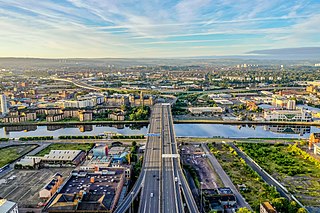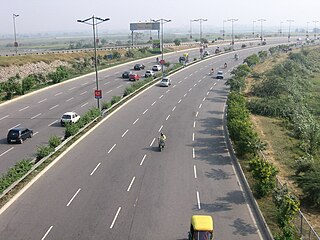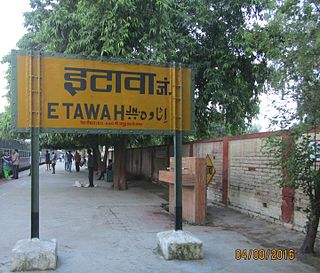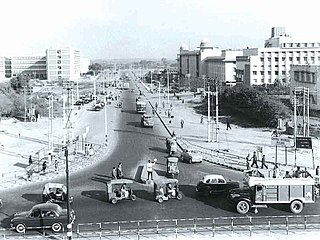
The M8 is the busiest motorway in Scotland. It connects the country's two largest cities, Glasgow and Edinburgh, and serves other large communities including Airdrie, Coatbridge, Greenock, Livingston and Paisley. The motorway is 60 miles (97 km) long. A major construction project to build the final section between Newhouse and Baillieston was completed on 30 April 2017. The motorway has one service station, Heart of Scotland Services, previously named Harthill due to its proximity to the village.

The city of Glasgow, Scotland, has a transport system encompassing air, rail, road and an underground light metro line. Prior to 1962, the city was also served by trams. Commuters travelling into Glasgow from the neighbouring local authorities of North and South Lanarkshire, Renfrewshire, East Renfrewshire, and East and West Dunbartonshire have a major influence on travel patterns, with tens of thousands of residents commuting into the city each day. The most popular mode of transport in the city is the car, used by two-thirds of people for journeys around the city.

Delhi has significant reliance on its transport infrastructure. The city has developed a highly efficient public transport system with the introduction of the Delhi Metro, which is undergoing a rapid modernization and expansion since 2006. There are 16.6 million registered vehicles in the city as of 30 June 2014, which is the highest in the world among all cities, most of which do not follow any pollution emission norm, while the Delhi metropolitan region has 11.2 million vehicles. Delhi and NCR lose nearly 42 crore man-hours every month while commuting between home and office through public transport, due to the traffic congestion. Therefore, serious efforts, including a number of transport infrastructure projects, are under way to encourage usage of public transport in the city.

The M4 Motorway is a 55-kilometre (34 mi) series of partially tolled dual carriageway motorways in Sydney designated as route M4. The M4 designation is part of the wider A4 and M4 route designation, the M4 runs parallel and/or below ground to Great Western Highway, Parramatta Road and City West Link, which are part of route A44.

Delhi Junction railway station, located in Chandni Chowk, Old Delhi, is the oldest railway station in Delhi, India. It is one of the busiest railway stations in the country, with around 250 trains commencing, terminating, or passing through it daily. Established in 1864, it originally served trains arriving from Calcutta.

The Delhi–Noida Direct Flyway or DND Flyway is India's first 8-lane wide, 7.5 km (4.7 mi) long access-controlled expressway in Delhi NCR. It connects Maharani Bagh and Nizamuddin on the western side to Noida (Sector-15A) and Mayur Vihar on the eastern side of the Yamuna river. The Noida Toll Bridge Company Limited (NTBCL) owned by IL&FS, operate and maintains it on build-own-operate-transfer (BOOT) basis. The expressway, which was opened to the public in January 2001 was constructed by Japan based Mitsui-Marubeni Corporation Ltd. The length of main carriageway (MCW), including bridge on Yamuna river is 6.0 km. Rest 1.5 km is Mayur Vihar link (MVL), which was opened in 2008.
Delhi, a major metropolitan region of India, is connected to various parts of country through several national highways and expressways. All the highways and expressways from Delhi lead to Haryana or Uttar Pradesh and continue from there.
The Western Peripheral Expressway (WPE) or Kundli–Manesar–Palwal Expressway, is an operational 6-lane, 135.6 km (84.3 mi)-long Expressway in the Haryana state of India. Along with the Eastern Peripheral Expressway, the Western Peripheral Expressway is expected to divert more than 50,000 heavy vehicles away from Delhi, which will help to maintain good air quality in Delhi. Western Peripheral Expressway along with Eastern Peripheral Expressway completes the largest Ring Road around Delhi. There are 10 tolled entries and exits, from north to south - Kundli, Kharkhoda, Bahadurgarh, Badli, Fartukhnagar, Panchgaon, Manesar, Taoru, Sohna & Palwal. Toll rate notified in December 2018 is INR1.35 per km for cars, INR2.18 per km for light motor vehicles, INR4.98 per km for trucks and buses, and two wheelers are not permitted on the expressway.

Expressways are the highest class of roads in India. As of December 2024, the total length of expressways in India was 6,059 km (3,765 mi), with 11,127.69 km (6,914.43 mi) under construction. As per NHAI and Indian Roads Congress, expressways are access controlled highways with a divided carriageway, designed for high speed vehicular movement and heavy traffic. There is a central reservation or median that separates the flow travelling in opposite directions. Entrance and exits are provided only by grade separated interchanges. The interchanges may be system interchanges used with other national or state highways or be service interchanges used with smaller roads. In contrast, National highways may or may not be divided by a median and may or may not have access control. Some highways, built by State Governments, which may be fully access controlled or may be limited access controlled, are declared or named as expressways by their respective State Governments.
The Eastern Peripheral Expressway (EPE) or Kundli–Ghaziabad–Palwal Expressway is a 135 km (84 mi) long, 6-lane wide expressway passing through the states of Haryana and Uttar Pradesh in India. The expressway starts from the Western Peripheral Expressway at Kundli, Sonipat, passing through Baghpat, Ghaziabad and Noida districts in UP and Faridabad district in Haryana before rejoining the Western Peripheral Expressway near Dholagarh, Palwal. Eastern Peripheral Expressway along with Western Peripheral Expressway completes the largest Ring Road around Delhi. The Eastern Peripheral Expressway was declared as National Expressway 2 (NE-2) in March 2006.
The Faridabad–Noida–Ghaziabad Expressway or FNG Expressway is an under-construction 56 km long, 6-lane wide expressway in Delhi NCR region of India. It will connect Faridabad in Haryana with Noida and Ghaziabad in Uttar Pradesh.

The Howrah–New Delhi main line is a railway line connecting Delhi and Kolkata cutting across northern India. The 1,531 km (951 mi) railway line was opened to traffic in 1866 with the introduction of the "1 Down/2 Up Mail" train.

The Agra–Lucknow Expressway is a 302 km long, 6-lane wide access-controlled expressway constructed by the Uttar Pradesh Expressways Industrial Development Authority (UPEIDA) to reduce traffic in already congested roads and to reduce pollution and carbon footprint. The expressway reduced the distance between the cities of Agra and Lucknow in the Indian state of Uttar Pradesh and is presently one of the India's longest operational expressways.

The Kanpur–Delhi section is a railway line connecting Kanpur Central and Delhi. This section includes Agra Chord and Etah link. The main line is part of Howrah–Delhi main line and Howrah–Gaya–Delhi line. The Agra–Delhi chord is part of Delhi–Mumbai line and Delhi–Chennai line.

The ITO barrage, also Indraprastha barrage and ITO Bridge, is a 552 meter barrage on Yamuna River, top of which also serves as the bridge on the Paharganj-Gaziabad Vikas marg. Yamuna flows for 48 km in Delhi, including 22 km from Wazirabad barrage where it enters Delhi to Okhla barrage after which it enters Haryana. Upstream barrage from ITO barrage in Delhi is Wazirabad barrage (north) and downstream is Okhla barrage (south). Yamuna has a total of 6 barrages, from north-west to south-east, Dakpathar Barrage (Uttarakhand), Hathni Kund Barrage, Wazirabad barrage, ITO barrage, Okhla barrage and Mathura barrage.
The Delhi–Mumbai Expressway is a 1,350 km long, 8-lane wide under-construction access-controlled expressway connecting India's national capital New Delhi to its financial capital Mumbai. The foundation stone for the project was laid by union minister of Road Transport & Highways Nitin Gadkari in the presence of Sushma Swaraj and Arun Jaitley on 8 March 2019 and it was inaugurated by Prime Minister Narendra Modi. The total project value including the land acquisition cost is around ₹1,00,000 crores. It is expected to be completed by 2026.

The Signature Bridge is a cantilever spar cable-stayed bridge which spans the Yamuna river at Shourya section, connecting Wazirabad to East Delhi. It is India's first asymmetrical cable-stayed bridge. The pylon of the Signature bridge is the tallest structure in Delhi and is double the height of Qutub Minar with its 154-metre high viewing box, which is a location where visitors take selfies. It shortens the travel time between north and northeast Delhi.

The Old Yamuna Bridge, also known as Lohe-ka-Pul, or "bridge number 249", located in Delhi, is one of the longest and oldest bridges in India. Construction of the bridge began in 1863 and finished in 1866, with it opening for public use in 1867. The bridge is a double-decked steel truss bridge that runs east-west across the Yamuna river, connecting the district of Central Delhi to the district of Shahdara. It was constructed in 1866 by the East India Railway at a cost of £1,616,335, and has a total length of 2,640 feet (804.67 m) feet with 12 spans of 202.5 feet (61.72 m) each.
Geeta Colony Bridge is a bridge in the city of Delhi, India. It crosses the Yamuna river, connecting the Trans-Yamuna area in East Delhi with Ring Road near Shantivan.
The Trans-Haryana Expressway or the Ambala–Narnaul Expressway (NH-152D) is a 227-km long, 6-lane wide greenfield access-controlled expressway, connecting the cities of Ambala and Narnaul in the state of Haryana. The expressway connects Gangheri village in Kurukshetra district with Surana village on Narnaul Bypass (NH-148B) in Mahendragarh district. It passes via Kaul, Pundri, Pillu khera, Julana, Kalanaur, Charkhi Dadri and Kanina. It will reduce the distance from Chandigarh to Delhi, Narnaul, and Jaipur, thus decongesting NH-44 and NH-48.













